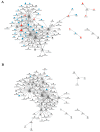Whole Transcriptome Analysis of Intervention Effect of Sophora subprostrate Polysaccharide on Inflammation in PCV2 Infected Murine Splenic Lymphocytes
- PMID: 37504299
- PMCID: PMC10377888
- DOI: 10.3390/cimb45070383
Whole Transcriptome Analysis of Intervention Effect of Sophora subprostrate Polysaccharide on Inflammation in PCV2 Infected Murine Splenic Lymphocytes
Abstract
(1) Background: Sophora subprostrate, is the dried root and rhizome of Sophora tonkinensis Gagnep. Sophora subprostrate polysaccharide (SSP1) was extracted from Sophora subprostrate, which has shown good anti-inflammatory and antioxidant effects. Previous studies showed SSP1 could modulate inflammatory damage induced by porcine circovirus type 2 (PCV2) in murine splenic lymphocytes, but the specific regulatory mechanism is unclear. (2) Methods: Whole transcriptome analysis was used to characterize the differentially expressed mRNA, lncRNA, and miRNA in PCV2-infected cells and SSP1-treated infected cells. Gene Ontology (GO), Kyoto Encyclopedia of Genes and Genomes (KEGG) and other analyses were used to screen for key inflammation-related differentially expressed genes. The sequencing results were verified by RT-qPCR, and western blot was used to verify the key protein in main enriched signal pathways. (3) Results: SSP1 can regulate inflammation-related gene changes induced by PCV2, and its interventional mechanism is mainly involved in the key differential miRNA including miR-7032-y, miR-328-y, and miR-484-z. These inflammation-related genes were mainly enriched in the TNF signal pathway and NF-κB signal pathway, and SSP1 could significantly inhibit the protein expression levels of p-IκB, p-p65, TNF-α, IRF1, GBP2 and p-SAMHD1 to alleviate inflammatory damage. (4) Conclusions: The mechanism of SSP1 regulating PCV2-induced murine splenic lymphocyte inflammation was explored from a whole transcriptome perspective, which provides a theoretical basis for the practical application of SSP1.
Keywords: Sophora subprostrate polysaccharide (SSP1); inflammation; murine splenic lymphocyte; porcine circovirus type 2 (PCV2); whole transcriptome analysis.
Conflict of interest statement
The authors declare no conflict of interest.
Figures











Similar articles
-
Sophora subprostrate polysaccharide targets LncRNA MSTRG.5823.1 to suppress PCV2-mediated immunosuppression via TNF/NF-κB signaling.Int Immunopharmacol. 2024 Sep 30;139:112701. doi: 10.1016/j.intimp.2024.112701. Epub 2024 Jul 17. Int Immunopharmacol. 2024. PMID: 39024747
-
Sophora subprostrate polysaccharide regulates histone acetylation to inhibit inflammation in PCV2-infected murine splenic lymphocytes in vitro and in vivo.Int J Biol Macromol. 2021 Nov 30;191:668-678. doi: 10.1016/j.ijbiomac.2021.09.119. Epub 2021 Sep 22. Int J Biol Macromol. 2021. PMID: 34560152
-
Sophora subprosrate polysaccharide inhibited cytokine/chemokine secretion via suppression of histone acetylation modification and NF-κb activation in PCV2 infected swine alveolar macrophage.Int J Biol Macromol. 2017 Nov;104(Pt A):900-908. doi: 10.1016/j.ijbiomac.2017.06.102. Epub 2017 Jun 27. Int J Biol Macromol. 2017. PMID: 28666830
-
Sophorasubprosrate polysaccharide suppress the inflammatory reaction of RAW264.7 cells infected with PCV2 via regulation NF-κB/MAPKs/c-Jun signal pathway and histone acetylation modification.Int J Biol Macromol. 2020 Sep 15;159:957-965. doi: 10.1016/j.ijbiomac.2020.05.128. Epub 2020 May 19. Int J Biol Macromol. 2020. PMID: 32442564
-
Platycodon grandiflorus polysaccharide inhibits the inflammatory response of 3D4/21 cells infected with PCV2.Microb Pathog. 2024 Apr;189:106592. doi: 10.1016/j.micpath.2024.106592. Epub 2024 Feb 28. Microb Pathog. 2024. PMID: 38423406
References
-
- Correa-Fiz F., Franzo G., Llorens A., Huerta E., Sibila M., Kekarainen T., Segalés J. Porcine circovirus 2 (PCV2) population study in experimentally infected pigs developing PCV2-systemic disease or a subclinical infection. Sci. Rep. 2020;10:17747. doi: 10.1038/s41598-020-74627-3. - DOI - PMC - PubMed
-
- Li X., Chen S., Zhang L.Y., Niu G.Y., Zhang X.W., Yang L., Ji W.L., Ren L.Z. Coinfection of porcine circovirus 2 and pseudorabies virus enhances immunosuppression and inflammation through NF-κB, JAK/STAT, MAPK, and NLRP3 pathways. Int. J. Mol. Sci. 2022;23:4469. doi: 10.3390/ijms23084469. - DOI - PMC - PubMed
-
- Han J.Y., Zhang S.X., Zhang Y.Q., Chen M.M., Lv Y.J. Porcine circovirus type 2 increases interleukin-1beta and interleukin-10 production via the MyD88-NF-kappa B signaling pathway in porcine alveolar macrophages in vitro. J. Vet. Sci. 2017;18:183–191. doi: 10.4142/jvs.2017.18.2.183. - DOI - PMC - PubMed
Grants and funding
LinkOut - more resources
Full Text Sources
Miscellaneous

